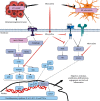Minocycline in Treating Glioblastoma Multiforme: Far beyond a Conventional Antibiotic
- PMID: 33014057
- PMCID: PMC7519463
- DOI: 10.1155/2020/8659802
Minocycline in Treating Glioblastoma Multiforme: Far beyond a Conventional Antibiotic
Abstract
One of the most lethal forms of CNS pathologies is glioblastoma multiforme (GBM) that represents high invasiveness, uncontrolled proliferation, and angiogenic features. Its invasiveness is responsible for the high recurrence even after maximal surgical interventions. Minocycline is a semisynthetic analog of tetracyclines with potential anti-inflammatory and anticancer effects, distinct from its antimicrobial activity. In this review, we highlight the importance and the cytotoxic mechanisms of minocycline on GBM pathophysiology. Considering the role of certain enzymes in autophagy, apoptosis, tumor cell invasion, and metastatic ability, the possible use of tetracyclines for cancer therapy should be investigated, especially GBM. The present study is, therefore, going to cover the main topics in minocycline pharmacology to date, encouraging its consideration as a new treatment approach for cancer and GBM.
Copyright © 2020 Amir R. Afshari et al.
Conflict of interest statement
The authors declare that there are no conflicts of interest regarding the publication of this paper.
Figures
Similar articles
-
The autotaxin-lysophosphatidic acid-lysophosphatidic acid receptor cascade: proposal of a novel potential therapeutic target for treating glioblastoma multiforme.Lipids Health Dis. 2015 Jun 18;14:56. doi: 10.1186/s12944-015-0059-5. Lipids Health Dis. 2015. PMID: 26084470 Free PMC article. Review.
-
Combined acetyl-11-keto-β-boswellic acid and radiation treatment inhibited glioblastoma tumor cells.PLoS One. 2018 Jul 3;13(7):e0198627. doi: 10.1371/journal.pone.0198627. eCollection 2018. PLoS One. 2018. PMID: 29969452 Free PMC article.
-
Minocycline: far beyond an antibiotic.Br J Pharmacol. 2013 May;169(2):337-52. doi: 10.1111/bph.12139. Br J Pharmacol. 2013. PMID: 23441623 Free PMC article. Review.
-
Anticancer Mechanisms of Berberine: A Good Choice for Glioblastoma Multiforme Therapy.Curr Med Chem. 2022;29(26):4507-4528. doi: 10.2174/0929867329666220224112811. Curr Med Chem. 2022. PMID: 35209812 Review.
-
CXCR4 antagonism sensitizes cancer cells to novel indole-based MDM2/4 inhibitors in glioblastoma multiforme.Eur J Pharmacol. 2021 Apr 15;897:173936. doi: 10.1016/j.ejphar.2021.173936. Epub 2021 Feb 10. Eur J Pharmacol. 2021. PMID: 33581134
Cited by
-
Novel Collagen Membrane Formulations with Irinotecan or Minocycline for Potential Application in Brain Cancer.Materials (Basel). 2024 Jul 15;17(14):3510. doi: 10.3390/ma17143510. Materials (Basel). 2024. PMID: 39063802 Free PMC article.
-
Microglia in Glioblastomas: Molecular Insight and Immunotherapeutic Potential.Cancers (Basel). 2024 May 22;16(11):1972. doi: 10.3390/cancers16111972. Cancers (Basel). 2024. PMID: 38893093 Free PMC article. Review.
-
The Assessment of Anti-Melanoma Potential of Tigecycline-Cellular and Molecular Studies of Cell Proliferation, Apoptosis and Autophagy on Amelanotic and Melanotic Melanoma Cells.Cells. 2023 Jun 6;12(12):1564. doi: 10.3390/cells12121564. Cells. 2023. PMID: 37371034 Free PMC article.
-
Inter-agency perspective: Translating advances in biomarker discovery and medical countermeasures development between terrestrial and space radiation environments.Life Sci Space Res (Amst). 2022 Nov;35:9-19. doi: 10.1016/j.lssr.2022.06.004. Epub 2022 Jun 14. Life Sci Space Res (Amst). 2022. PMID: 36336375 Free PMC article.
-
How do phosphodiesterase-5 inhibitors affect cancer? A focus on glioblastoma multiforme.Pharmacol Rep. 2022 Apr;74(2):323-339. doi: 10.1007/s43440-021-00349-6. Epub 2022 Jan 20. Pharmacol Rep. 2022. PMID: 35050491 Review.
References
-
- di Cerbo A., Pezzuto F., Guidetti G., Canello S., Corsi L. Tetracyclines: insights and updates of their use in human and animal pathology and their potential toxicity. The Open Biochemistry Journal. 2019;13(1) doi: 10.2174/1874091x01913010001. - DOI
Publication types
LinkOut - more resources
Full Text Sources


